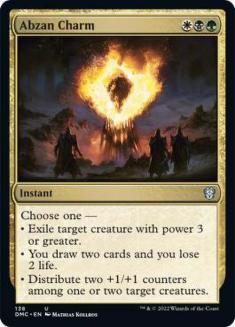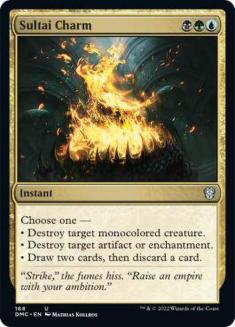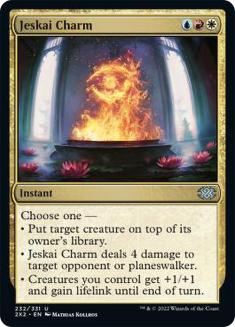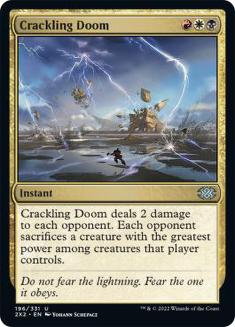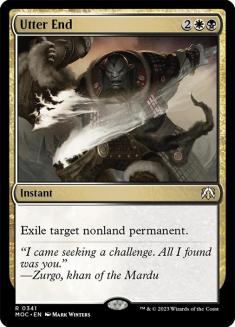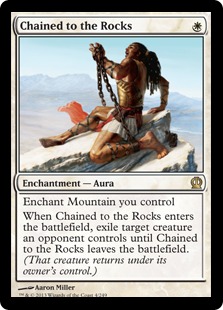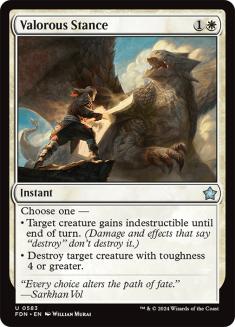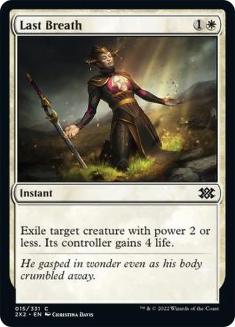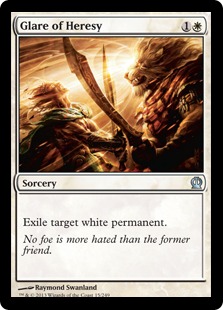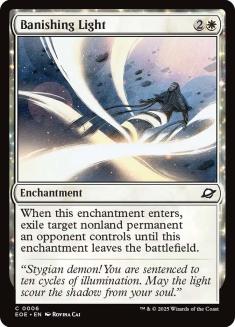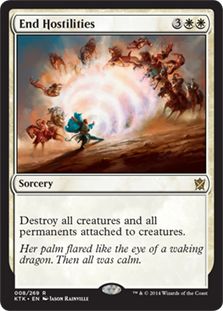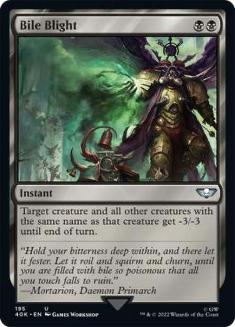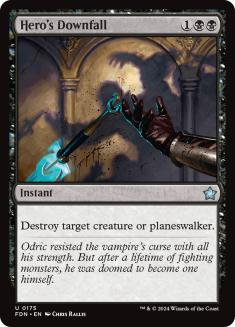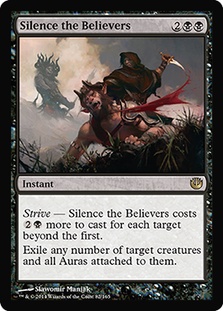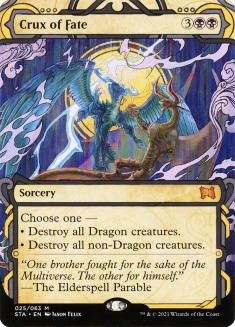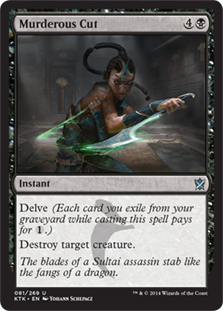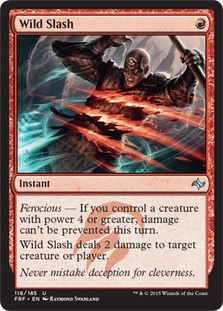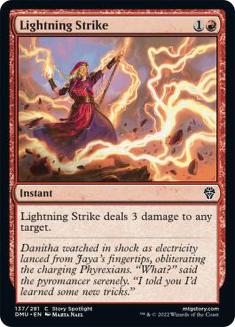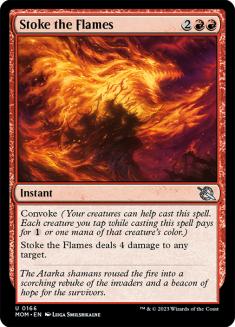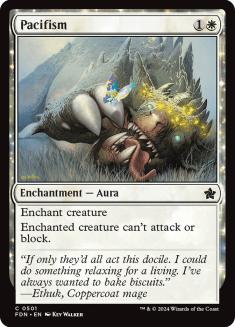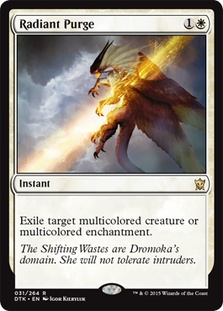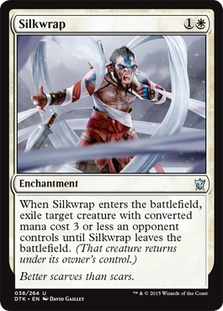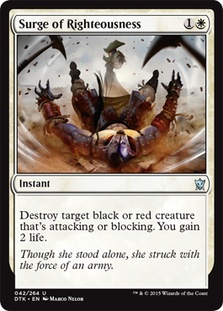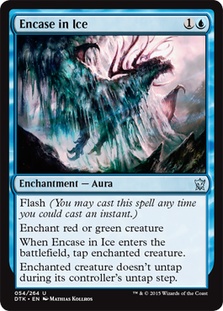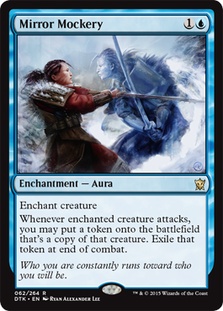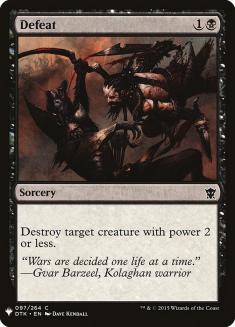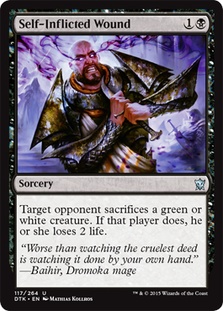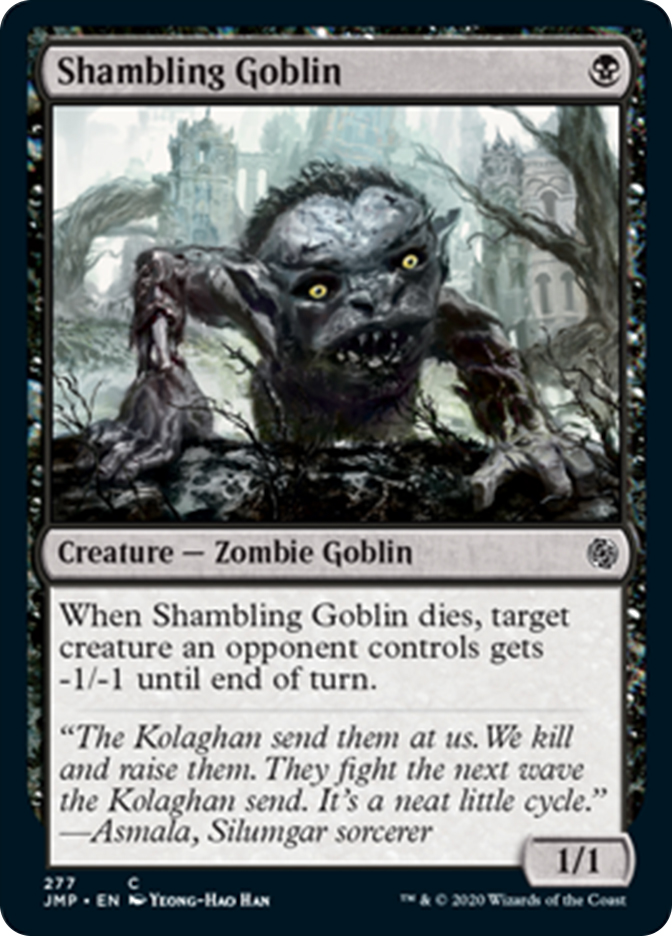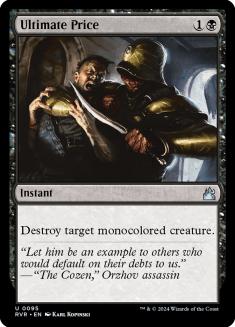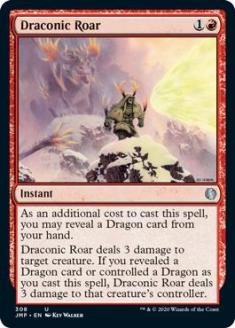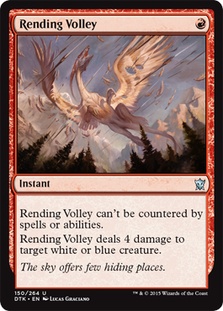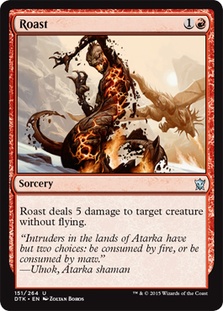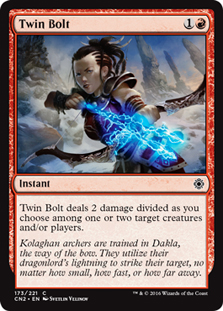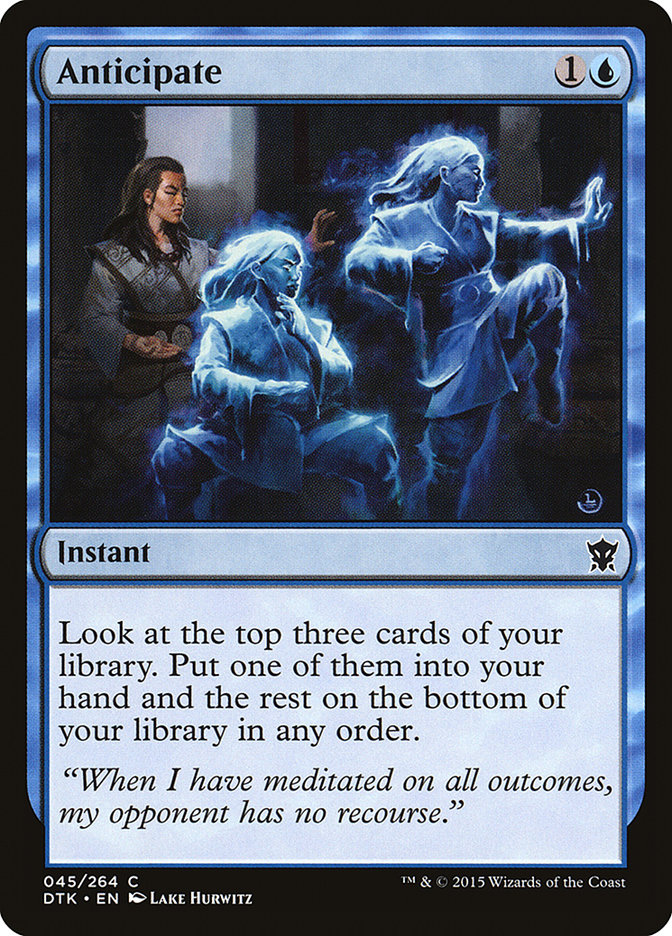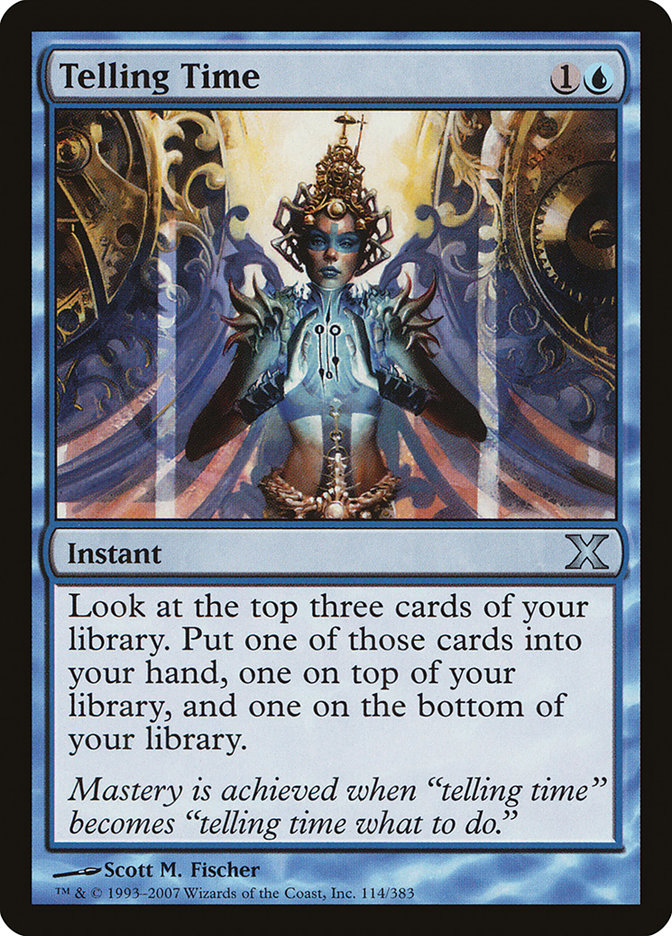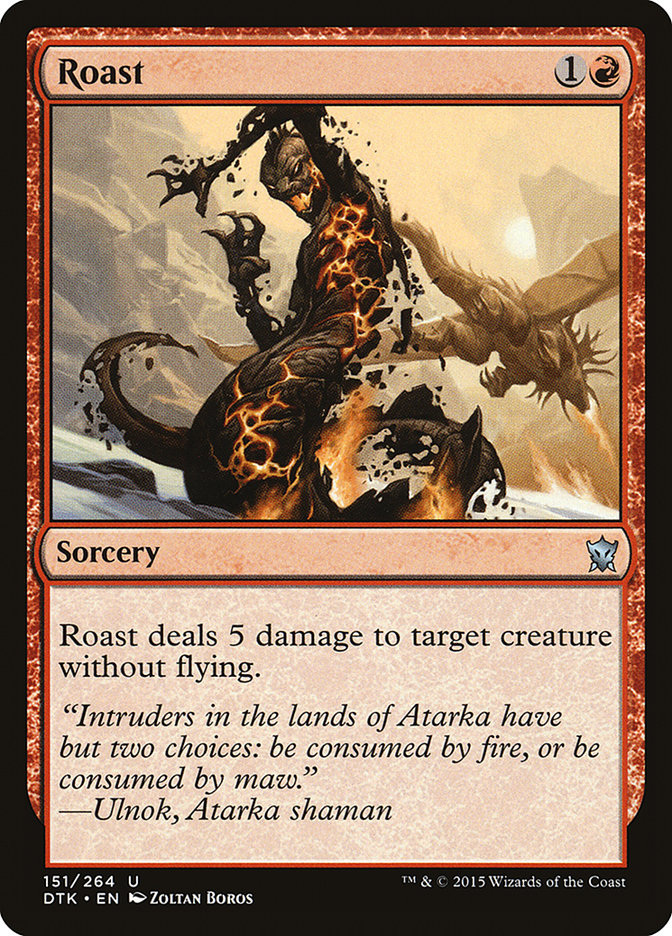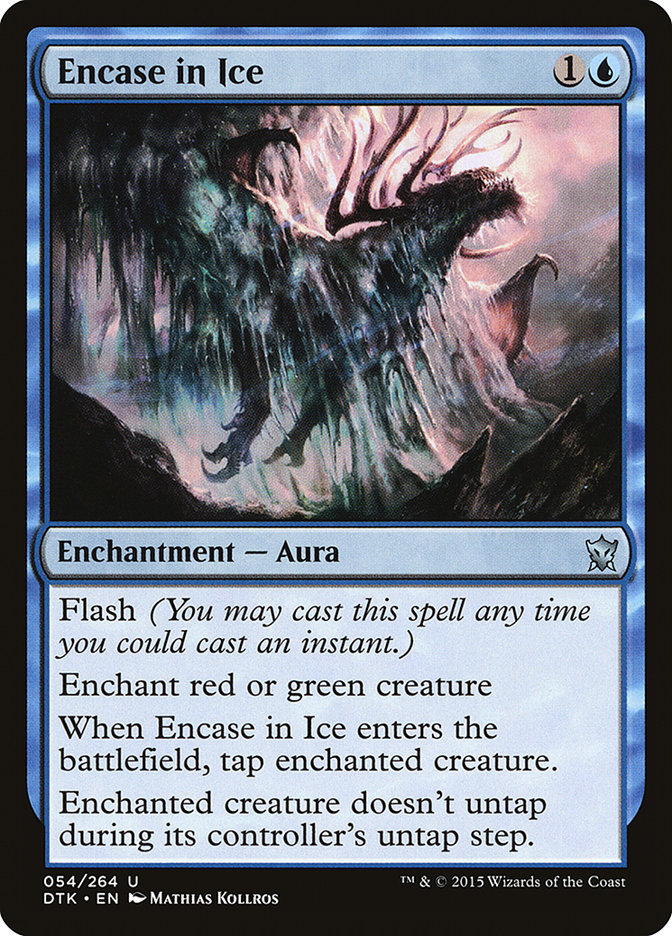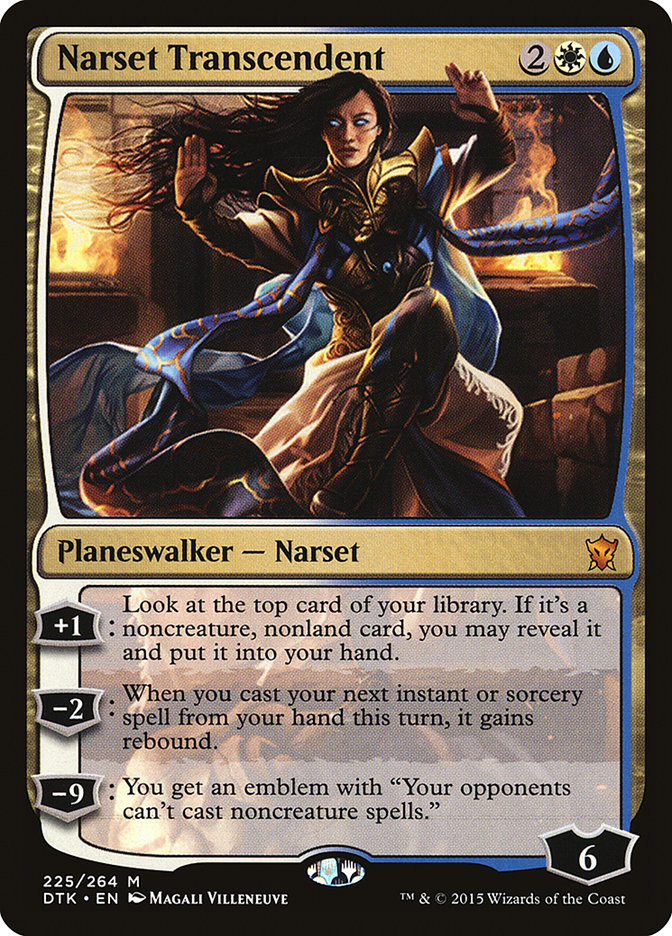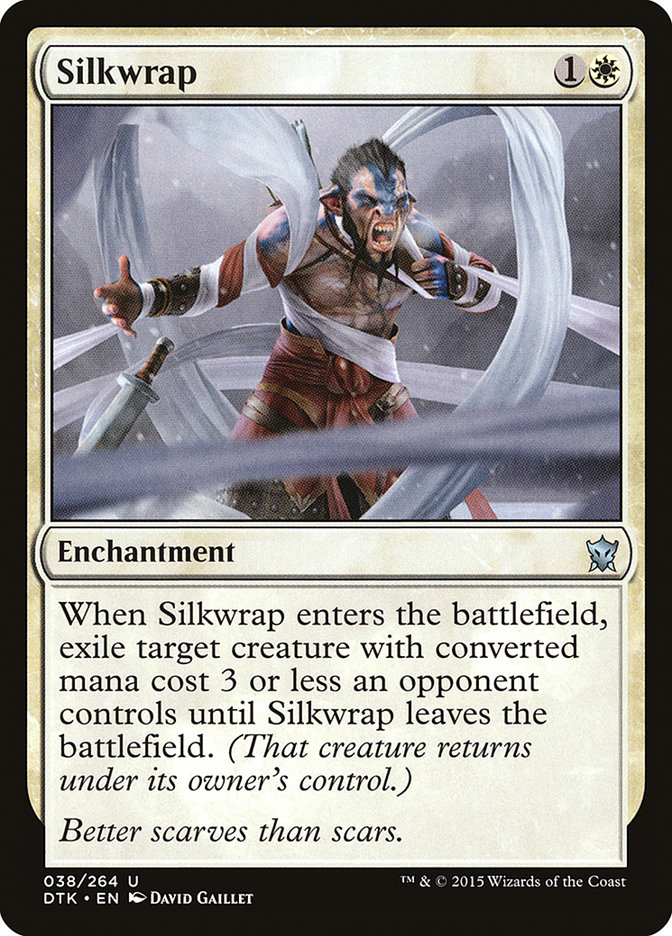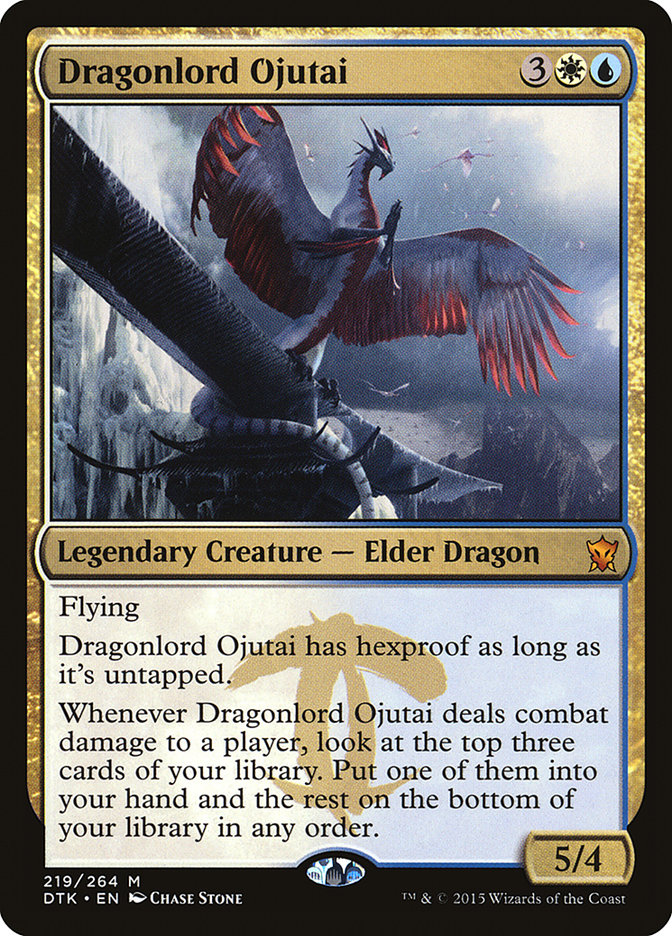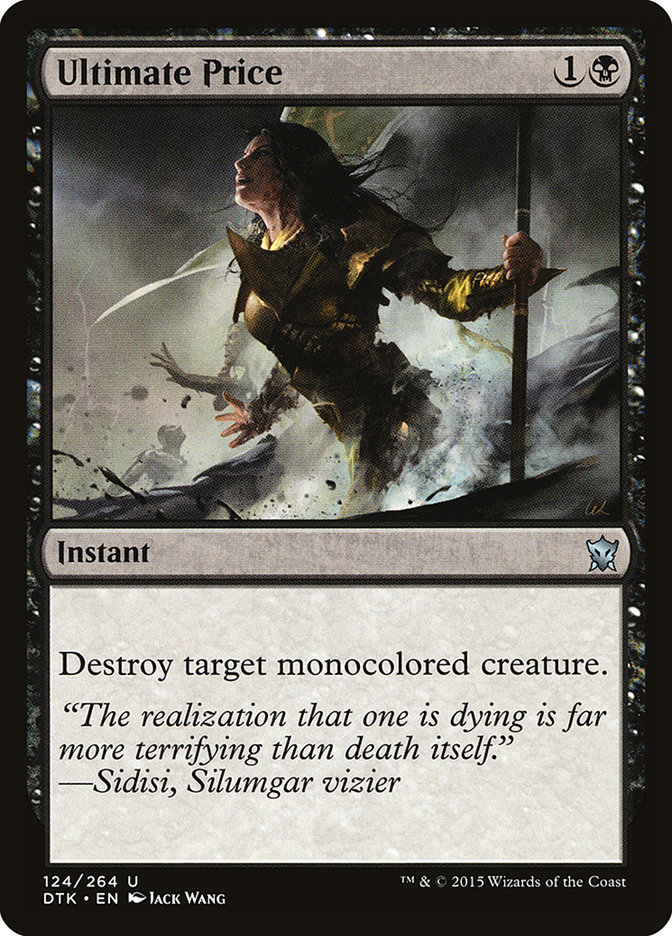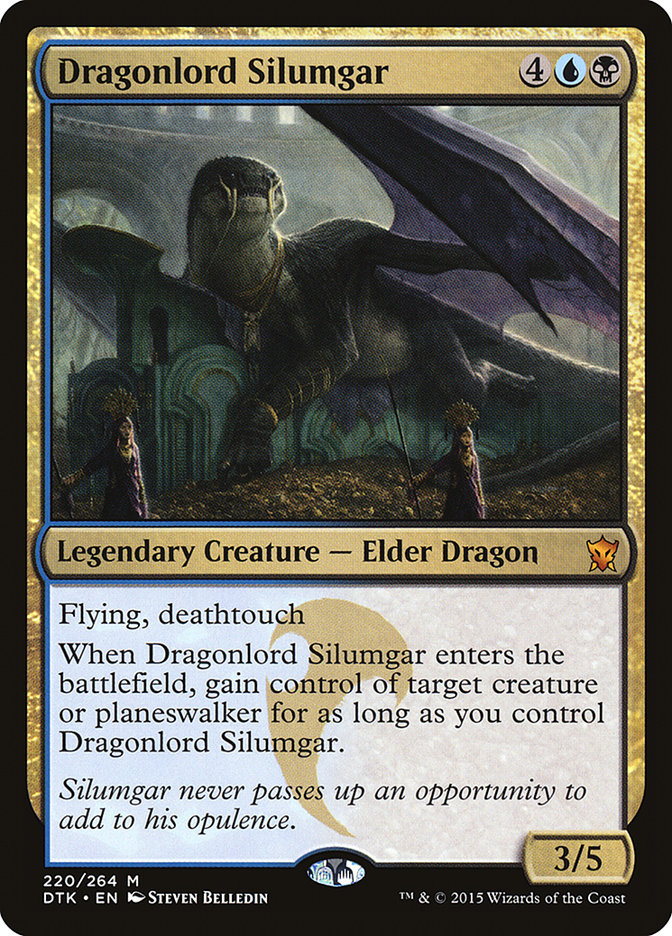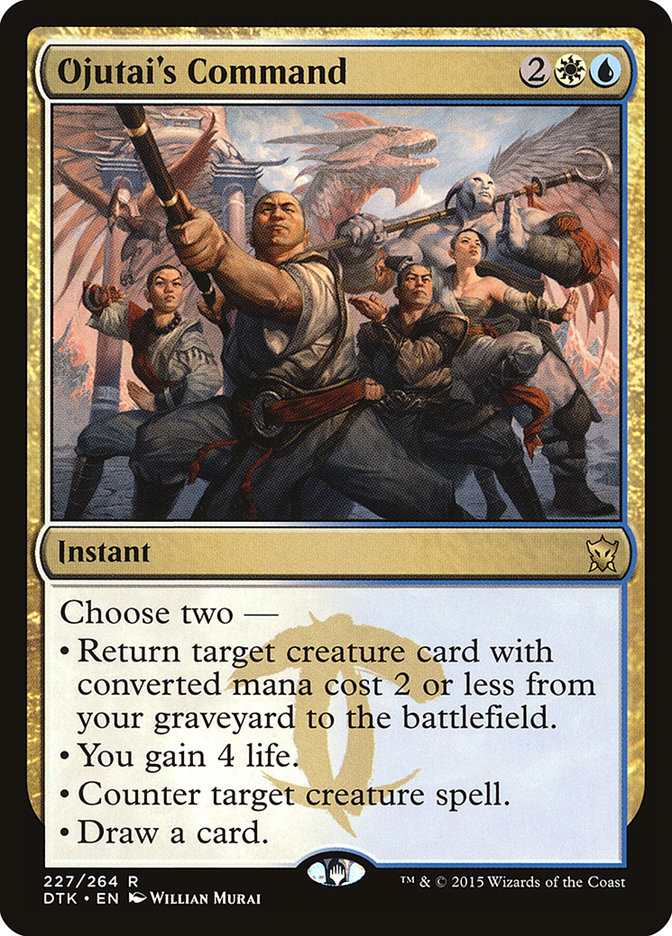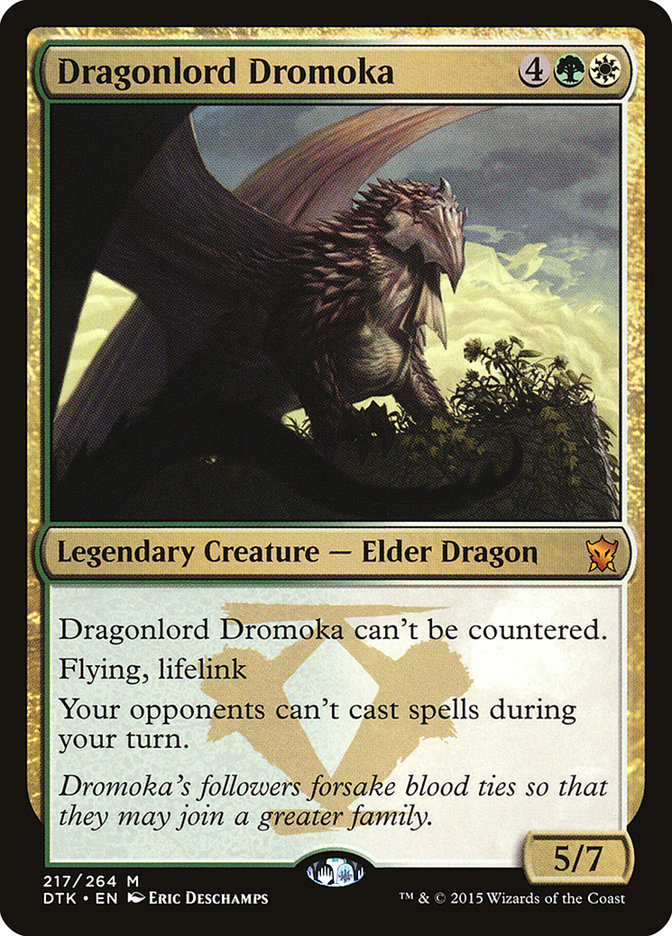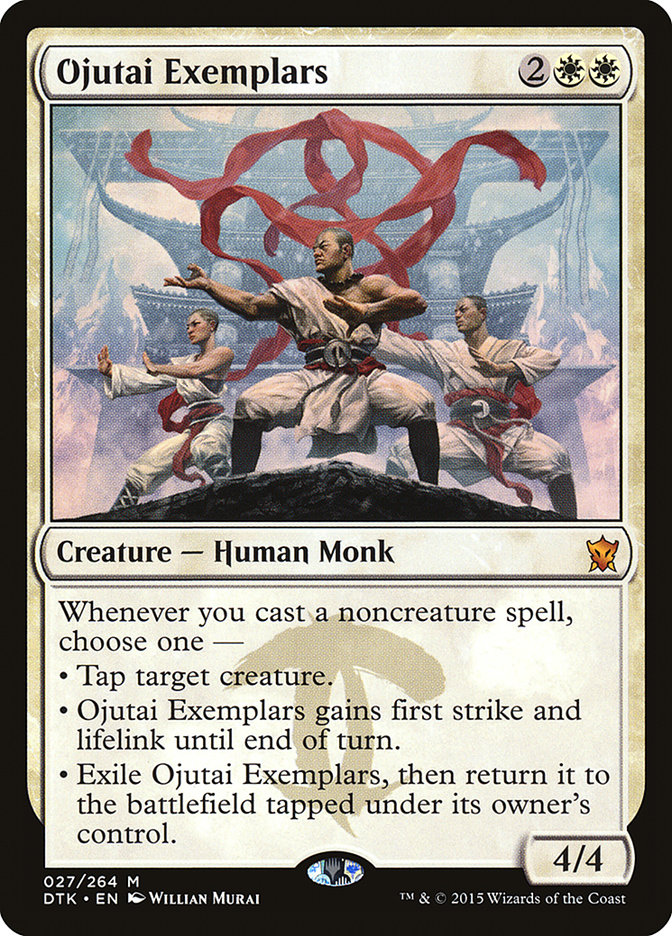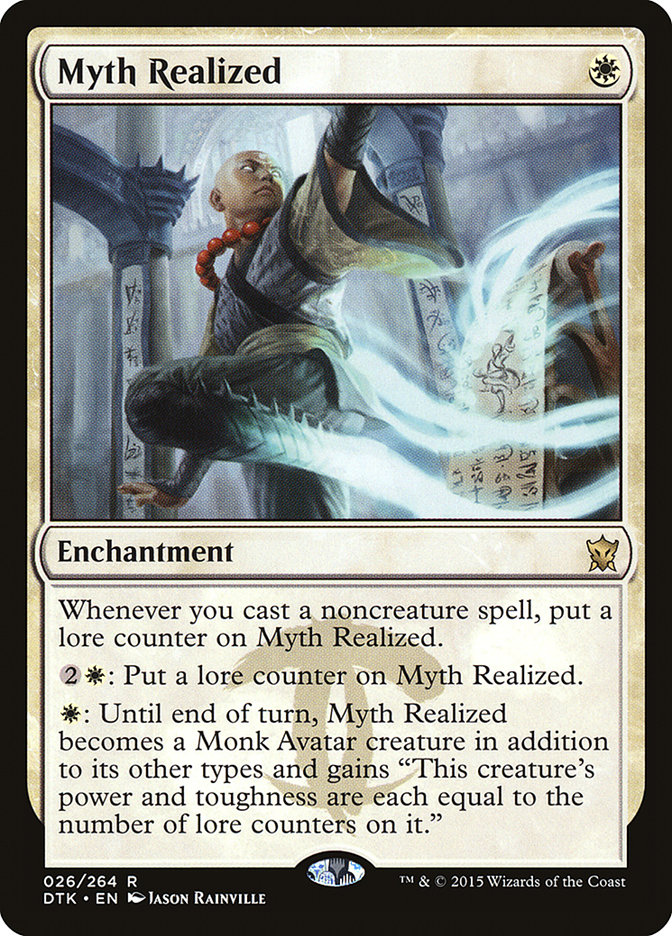Everything is about to change.
Dragons of Tarkir has a ton of great cards, no question, but that’s not even the important thing. Not really. What’s so revolutionary about this set is the
complete overturning of existing design philosophy on two-cost removal spells.
Just look at the removal spells in the pre-Dragons of Tarkir world.
There’s tons of great removal for three or more mana, but the only options for two or less are limited to small creatures (Wild Slash, Lightning Strike,
Bile Blight) or are white (and still very limited).
Dragons of Tarkir has an almost comical amount of two-cost removal to choose from, giving us an enormous array of options for how best to interact with the
threats we anticipate being popular.
As if a metric ton of two-cost removal wasn’t enough to change the format, there’s also the triumphant return of devotion, a ton of bomb victory
conditions, two high level new planeswalkers that are great at drawing cards, and the best cheap library manipulation spell since Ponder!
I’ve heard very mixed things about this one, in particular, with some people suggesting it’s worse than Telling Time.
While I have no doubt that Telling Time was designed by a very attractive man, it is not exactly breath-taking in power level. It was definitely playable,
of course, most popularly in Dragonstorm decks, but it’s nowhere near the same league as the hyper-efficient Preordain or Ponder.
After the printing of Snapcaster Mage, Wizards of the Coast appeared to take a sharp turn away from cheap, efficient library manipulation. Return to
Ravnica block, Theros block, and Khans of Tarkir block were all completely devoid of that style of aggressive library manipulation. However, Anticipate
appears to be a rare return to the old philosophy, and the power level is no joke.
How does Anticipate compare to Telling Time? Well, the only difference (aside from legality) is that Telling Time forces you to draw one of the two rejects
next turn instead of a new card. What’s better, a random card or the second best card out of three? And how big of a difference is that?
Well, it’s not that big of a deal, but it is important. While it can be tempting to imagine that a random card is worth the same, on average, as a
“middle third” quality of card, that’s not actually super accurate. Typically, when we use library manipulation, there are specific things that we want.
Sometimes, we just want any land, but often we are digging to something specific, such as a removal spell, a sweeper, a big card draw spell, or a victory
condition to start winning the game.
When you cast Anticipate, you get three chances at whatever it is you are looking for, then a fourth shot when you untap (your draw for the turn). With
Telling Time, you only get three chances, rather than four.
Turn 2 looking for a third land in your 26-land deck?
● Telling Time gives you an 86% chance.
● Anticipate gives you a 93% chance.
“Wait,” you might be saying. What if there are two lands from my Telling Time? Actually, a turn 2 Anticipate with no land in hand is slightly better at
making sure you hit four on turn 4 than a Telling Time under the same conditions.
● Telling Time gives you a 65% chance.
● Anticipate gives you better than a 66% chance.
Anticipate is also superior to Telling Time when you are looking for something specific, such as one of your four Dig Through Times.
● Telling Time gives you a 19% chance of finding one by your next turn.
● Anticipate gives you a 25% chance of finding one by your next turn.
Anticipate gives you the greatest shot at finding whatever it is you actually want, since it effectively lets you look a card deeper. So, where would
Telling Time shine? Telling Time gives you greater insurance that you will draw two copies of a class of card, if your deck is over 50% that card, for
instance, if you just want to draw two spells by next turn.
● Telling Time gives you a 60.1% chance of drawing two spells by next turn.
● Anticipate gives you a 52.4% chance of drawing two spells by next turn.
While there is some value in the midgame to having a quantity of non-land draws, it is far better to have more chances at the best cards you could draw.
Anticipate may be strictly worse than Impulse, but Impulse hasn’t been Standard legal in sixteen years and was a Vintage staple at various points.
Whenever I am building control decks for a new format, I like to remember Guillaume Wafo-Tapa’s approach to deckbuilding. He starts by trying two-color control decks, as they
are inherently more likely to have better mana. While he wants to find a control deck that works, he is constantly searching for a fatal flaw in the color
combination that lets him rule it out. He starts with the color combination he thinks is least likely to work in order to rule out decks more efficiently.
Sometimes, this doesn’t even require a deck to get built if the fatal flaw is obvious.
For instance, given U/G’s lack of removal and interaction, I immediately identified it as the least likely to succeed among Dragons of Tarkir two-color
control decks. Courser of Kruphix, Aetherspouts, and Prophet of Kruphix are all cards, but every time I try to imagine what a U/G control deck might look
like, it turns into Green Devotion or Blue Devotion. There’s nothing wrong with that, but those aren’t really control decks. Besides, U/G Control wasn’t a
thing pre-Dragons of Tarkir, and there isn’t really anything in the set that helps it more than any other color combination.
My next stop was U/R Control, which seemed less likely than white or black because of its weakness against larger creatures. Interestingly, it gained a
very important new card that might actually be the missing link that makes this archetype viable.
Creatures (3)
Planeswalkers (1)
Lands (26)
Spells (30)

Roast may not be able to go upstairs, but it can kill Siege Rhinos and Tasigurs, something the strategy sorely needed. This doesn’t solve everything,
however, as Dragons of Tarkir introduces many new threatening fliers too big to Lightning Strike. Besides, Stormbreath Dragon and Wingmate Roc were already
reasonably popular cards.
This list attempts to use Aetherspouts, Perilous Vault, Ugin, and even the miser’s Master the Way to try to address that weakness. Those are, for the most
part, also this build’s attempted answers to planeswalkers (along with Lightning Strike, at times), as Fated Conflagration is aggressively mediocre and
cuts into our ability to play Radiant Fountain.
Master the Way might prove too clunky, but the combo kill aspect of it is attractive. Cast Pearl Lake Ancient on your opponent’s end step, untap, then
return all of your land to your hand by activating Pearl Lake Ancient’s ability three or more times. Then cast Master the Way for Tons Of Damage!
While 27 and 28 land has been the norm for control decks lately, Anticipate is probably going to usher in a new era of 26 land counts. It’s not that you
anticipate wanting to dig for land, it’s just that we were only playing that much land before because of how ruinous it is to miss any of our
first five land drops. Land counts that high increase the risk of flood, but now, we actually have better chances of hitting our mana early while also
flooding out less late.
Chances of five land by turn 5:
● With 28 land – Approximately 66.2%
● With 26 land and 4 Anticipates – Approximately 70.6%
Encase in Ice is an important new addition as well, as it helps address some of our weaknesses to fatties. It’s also nice that it fairly effectively
answers Fleecemane Lion and Deathmist Raptor. The Lion gaining hexproof doesn’t knock the aura off once attached.
Ugin and Perilous Vault address a lot of the typical weaknesses of U/R Control, and Anticipate and Roast are big enough additions, I don’t think we can
rule this one out without testing.
Up next is U/W Control, one of the most talked about strategies given the general excitement level over the latest four-cost planeswalker on the block.
Narset has the potential to go in a lot of decks, and she looks great. It’s very easy to play a deck that has more than half of its cards hits for her.
Just drawing a card half the time would be something, like Domri Rade. The list that follows actually draws a card 54.2% of the time. Once you factor in
controlling the top of your library with scrying, it’s even higher.
It’s not like missing with Narset is the end of the world. If you needed a land, you know you’re drawing it next turn. If you don’t, you can Anticipate,
letting you get a fresh draw next turn on top of the usual best of your top three.
Narset’s rebound ability is going to have very different value depending on which deck is using it. The typical way to really abuse it is to copy your Dig
Through Time (or Treasure Cruise), which should really snowball your card advantage. If you drop Narset against a Hero’s Downfall deck on turn 6, either
blue delve card is going to create a massive supply of card advantage that is usually going to be a nightmare for decks trying to trade cards with you.
Another oft-quoted use is rebounding End Hostilities the turn after you cast Narset, effectively buying you an untap with an empty board the following
turn. It’s definitely cute, but I am not totally sure how often this play is actually going to be necessary. It is still good to have in your arsenal
though.
Narset’s ultimate means you can actually take full control of a game, hardlocking people from trying to burn you out, dropping an Ugin, or ripping a
Downfall for your Elspeth. That she has so much loyalty means she’s actually going to soak up a lot of damage for you, often buying you so much needed
time.
Creatures (1)
Planeswalkers (6)
Lands (26)
Spells (27)

This could easily be too great of a reliance of white enchantments for removal, but Silkwrap looks pretty respectable to me.
Last Breath doesn’t exactly set a high bar, but Silkwrap also hits Mantis Rider, Anafenza, the Foremost, Brimaz, King of Oreskos, Deathmist Raptor, and
sometimes even Savage Knuckleblade or Shorecrasher Elemental.
While the card is not as powerful or as flexible as Valorous Stance, it does address the threats we actually need to answer during the first three turns of
the game.
He protects himself the turn you drop him, sure, but you do need to be able to protect him after that if you want his full power. After sideboarding, there
will be less he needs to be protected from. That said, Dragonlord Ojutai is definitely a maindeck consideration, particularly if we end up playing some
amount of Silumgar’s Scorns, more Negates, or Valorous Stance.
Encase in Ice is particularly important in U/W because of our vulnerability to Stormbreath Dragon. That said, with this many enchantments, our opponents
are going to love it if they have access to any Back to Natures.
I originally considered the card Gainsay in the sideboard, thinking that the return of Blue Devotion could make it a valuable tool. The thing is, many of
the great new Blue Devotion cards are megamorphs that can dodge Gainsay by being cast face down.
Up next, we have the two-color control deck of choice lately, U/B Control. While U/B Control doesn’t gain anything as flashy as Narset, it does gain one of
the most important cards to come out of Dragons of Tarkir.
Ultimate Price is far, far more flexible than most of the two-mana options we’ve talked about today. It is not only maindeckable, but maindeckable in large
numbers. It’s a great turn 2 play, but it’s also a great turn 6 play. It’s going to put pressure on people to play more gold creatures, like Mantis Rider,
and less mono-color creatures, like Goblin Rabblemaster.
Creatures (2)
Planeswalkers (3)
Lands (26)
Spells (29)

Haven of the Spirit Dragon is a super exciting new addition to control decks. The opportunity cost is so low, and going long, it gives you another way to
ensure you don’t run out of victory conditions. The card has other applications in more dedicated Dragon decks, but even with just a couple things to get,
it’s often better than just using another basic.
I might be jumping the gun, but I want to be a little cautious about Disdainful Stroke. There are enough good cheap cards in this set, it’s possible that
maindecking large quantities of it is too risky. As such, I have hedged with a maindeck Negate instead of the third.
Dragonlord Silumgar is definitely a maindeck consideration despite the bull’s eye on his head. Outside of being outrageously powerful in general, his
ability to steal planeswalkers the turn before they ultimate is going to steal a lot of games. Besides, a 3/5 flying deathtouch creature is pretty hard to
attack into, holding off Siege Rhinos and Stormbreath Dragons (for a while), while also dodging a lot of removal spells like Ultimate Price, Roast, and
Stoke the Flames.
Once we know what the best two-color control decks are, we can compare them to the three-color (or more) control decks to see if the added power is worth
the impact on our mana. Here are some attempts at three-color builds, though once we learn what the real weaknesses of the two-color decks are, we will be
better equipped to find the third color that shores up these weaknesses.
Creatures (5)
Planeswalkers (4)
Lands (25)
Spells (26)

Sultai Control gets Anticipate and Ultimate Price, just like U/B Control; however, it appreciates them slightly less, as it already had Satyr Wayfinder at
the two-spot. It’s not that they don’t work together, it’s just that Sultai needed the new two cost spells less. It might be crazy to only play three
Anticipates, but the combination of tapped lands slowing us down, Sultai Charm (for more manipulation), and plenty of two-cost spells certainly make it
worth considering trimming one (since three is the go-to number of a card to play if you like drawing one a lot, but really do not want to draw two, which
in this case might be because of it being too slow).
Haven of the Spirit Dragon is particularly interesting in Sultai. The pressure it puts on your mana is not trivial, though Anticipate does help in this
area. The part that is great about it, however, is the insurance it provides against flipping your Ugin (or Silumgar) to a Satyr Wayfinder, and since the
Haven is a land, you can actually find it with the Satyrs. Now, instead of one less option to win with, you actually give yourself selection, since
flipping one means one of your lands has an extra option compared to before.
While a lot of people have talked about Esper as the next big thing, I am skeptical. The new set gives us tons of great cheap interactive cards and plenty
of victory conditions for all. What it doesn’t do is give us new dual lands. This makes me more likely to play two colors, not less. If we want to
play Esper, I think the way we arrive there is by finding some fatal flaw in U/B and U/W that require borrowing something from one of them and splashing it
in the other.
Planeswalkers (7)
Lands (26)
Spells (27)
- 4 Ultimate Price
- 4 Hero's Downfall
- 4 Dissolve
- 1 Aetherspouts
- 2 Perilous Vault
- 1 Utter End
- 2 Disdainful Stroke
- 4 Dig Through Time
- 1 Crux of Fate
- 4 Anticipate
Sideboard

Even just sketching out this list, I had to force myself to not cut the white cards. Of course, I could have also played up the white part of the deck, but
that makes me wonder why we have black. I guess I am just not sold on why we need both, because the mana is not exactly awesome. We don’t have a tri-land,
and it’s hard to play Polluted Delta and Flooded Strand at the same time. Plus, we lose out on Radiant Fountain and Haven of the Spirit Dragon.
Of course, playing lots of different planeswalkers is a good time…
Creatures (8)
Planeswalkers (7)
Lands (24)
Spells (21)

This take on Bant Control is built around the combination of Narset and Courser of Kruphix. Not only does Courser protect Narset, they both make the other
substantially more likely to hit. Normally, Courser is about 40% to draw a card each turn, and Narset is about 47%. Put them together, however, and now
Courser is 58.8% to hit and Narset is 65.8%. That’s because if the top card is a land, play it and then decide whether to Narset. If the top card is a
non-creature spell, Narset. Then you have a fresh look for Courser. If you happen to get bricked on a Satyr or another Courser, you might have access to a
fetchland, scry, Kiora, an Anticipate, a Dig Through Time, or a Wayfinder in hand to reset the top.
A lot of people are freaking out about Ojutai’s Command, and it is pretty good, but I am not sold on this as a four-of in every U/W deck. Admittedly, Satyr
Wayfinder is less good to get back than Soulfire Grand Master or Seeker of the Way. Either way though, it gives us a lot of nice options, and if it
performs well, could prove to be a three- or four-of after all.
Dragonlord Dromoka is more than just a sideboard Baneslayer Angel, though she does excel at that. She is functionally an uncounterable Abeyance, locking
your opponent out from interacting with you the turn you cast her. This means you can play her on turn 8 and then force through a Dig Through Time or
Treasure Cruise, uncounterable. You’ve got to be careful about walking face first into an Ugin, but this is a powerful tactical weapon against Counterspell
decks, particularly once they sideboard out a bunch of their removal.
Creatures (7)
Planeswalkers (2)
Lands (24)
Spells (27)

There are so many configurations to try with Jeskai, it’s hard to decide where to start. The core of this list is the interaction between Jeskai Ascendancy
and Dragonlord Ojutai, which makes Ojutai extremely hard to kill, while snowballing the game with card advantage and selection.
Ojutai Exemplars is a little bit of an oddball, but it could actually be great. It’s not like a 4/4 for four is that far off, and those are a lot of great
abilities. The more must-kill creatures you play (Soulfire Grand Master, Monastery Mentor, Brimaz, Goblin Rabblemaster), the better it gets. My biggest
concern is the vulnerability to Ultimate Price, at times, but if you ever have mana open, you are always threatening to blink it. It’s an unusual card, to
be sure, but it takes over a game while also protecting itself. That makes me very interested.
Myth Realized might just be too mana-hungry and slow, but it might also prove an invaluable tool for prowess decks looking for more big threats that keep
their spell count high. Here, it is a speculative alternative victory condition that probably isn’t as good as something more versatile.
What about Temur Control? After all, that new Sarkhan looks great, right?
Well, yes, Sarkhan does look great, but every time I try to build a Temur Control deck, it turns into a Temur Midrange Planeswalker or Monsters deck.
There’s nothing wrong with that, but none of the lists ever end up looking like control and are for another day.
There’s also the possibility of not playing blue in our control deck. Abzan Control is a real thing, and in fact, we could actually play W/B Control, or
even Mono-Black if we wanted. The printing of Duress to go alongside Thoughtseize reduces the need for counterspells, and black has a number of card draw
options. In addition to Read the Bones and Sign in Blood, Damnable Pact gives us some serious power while also serving as another road to victory.
With Thoughtseize, Sign in Blood, Read the Bones, and Damnable Pact offering us power for life, lifegain might prove to be the bottleneck. Whip of Erebos
and Gray Merchant are the first cards that come to mind for Mono-Black, and white adds Sorin, Solemn Visitor, Seeker of the Way, Hidden Dragonslayer,
Ojutai Exemplar, and Wingmate Roc.
Creatures (10)
Planeswalkers (3)
Lands (25)
Spells (22)
- 4 Thoughtseize
- 2 Ultimate Price
- 4 Read the Bones
- 4 Hero's Downfall
- 2 Bile Blight
- 1 Utter End
- 3 Valorous Stance
- 2 Damnable Pact
Sideboard

Whatever direction you want to go, Dragons of Tarkir is radically changing the landscape of the format. With the Prerelease fast approaching, let me know
what card or deck you most want to see. Everything is fair game.
Let the brewing begin!


